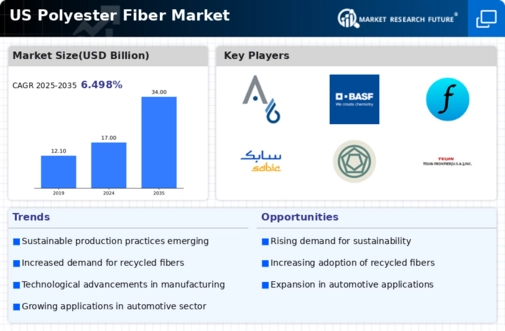The competitive landscape of the US Polyester Fiber Market is characterized by a dynamic interplay among a myriad of players aiming to establish their dominance within this segment. With the growing demand for durable and high-performance textiles, coupled with the increasing applications of polyester fibers across various industries including automotive, construction, and packaging, companies are continuously innovating and enhancing their product offerings to cater to the evolving needs of consumers. The market's landscape is marked by strategic partnerships, technological advancements, and aggressive marketing strategies, all focusing on boosting production capabilities and ensuring sustainable practices.
This competitive environment drives firms to explore diverse channels for market penetration and customer engagement while tailoring their operations to maintain a competitive edge.Mitsubishi Chemical Corporation stands out as a key player in the US Polyester Fiber Market, leveraging its strong R&D capabilities to develop innovative products that meet consumer expectations for quality and sustainability. The company maintains a significant market presence, driven by its commitment to producing environmentally friendly polyester fibers. With a focus on enhancing performance, Mitsubishi Chemical Corporation excels in creating fibers with unique properties suited for various applications, including textiles and industrial applications.
The company’s strengths lie in its comprehensive supply chain, advanced manufacturing processes, and a robust distribution network, which collectively facilitate efficient service delivery and ensure a steady supply of products to its customers across the United States.Lenzing AG is another notable entity within the US Polyester Fiber Market, recognized for its commitment to sustainability and innovation. The company is known for its high-quality products, including TENCEL and Lenzing Modal fibers, which offer distinctive features such as breathability and moisture management.
Lenzing AG has established a strong market presence, particularly in the eco-conscious consumer segment, positioning itself effectively to cater to the rising demand for sustainable textile solutions. Lenzing AG's strengths lie in its continuous investment in cutting-edge technologies and sustainable practices, along with effective collaborations and partnerships that enhance its operational efficiency. The company's strategic mergers and acquisitions have further bolstered its market position, allowing it to expand its influence and offerings in the US market while responding to consumer trends for sustainable and innovative fiber solutions.


















Leave a Comment